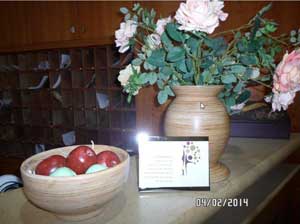
Rob’s editorial last time out referred to having a sense of humor in woodworking (or about your woodworking …). – Editor
“Just a reply to your ‘Funny Ha-Ha.’ I have two signs in my shop. The first, “NO Smoaking.” The second, “PAPA’S WOULD SHOP.” A good sense of humor is required not only in woodworking but in life as well. My granddaughter asked me what my favorite color is and I answered purple, however I spelled it for her per-pull. After all, if we can’t have fun then why bother? There are enough serious matters that we have to deal with! Keep up the good work.” – Thomas Cleveland
Lights, Camera, Video
Some other readers had something to say about Rob’s “Edging Hardwood Plywood with Solid Lumber” Tricks of the Trade video last time out. – Editor
“Great issue, Rob. I especially like the video on edge banding plywood. I have found these eZine issues very informative. Keep up the good works.” – Henry Simon
“I could not help but see a difference between your photo and your video. Has someone thrown some light-colored sawdust into your hair and goatee? Maybe you need to start working with darker colored woods such as walnut.” – Jim Severson
A Project He Loves
After a discussion in last issue’s WebSurfer’s Review section about “Projects You Love,” we heard from some reader who wanted to share their favorite projects. – Editor
“It is a coffee table that I built while still in high school. Basic size is 24″ x 48”. I built it out of Bruce hardwood flooring, oak, left over from when my dad added on to our house. He had some extra lying around and he was actually going to throw it out. I asked him to keep it and I would think of something to build in shop class using it. I came up with the coffee table idea. Ordered some simple wrought-iron legs for it from a book my teacher had. I edge glued the flooring together on a ½” thick piece of plywood. Used some 1-1/2″ square lengths trimmed out to 1/4 inch, “L” shaped, on the table saw for edging. Used what was left of the 1-1/2″ square stuff to make three cross-sections under the tabletop, but it still warped a little on one end. The one thing that I would have done different, I would have used 3/4″ plywood for the backer to try and keep it from warping. A grown man can stand on that thing and it won’t even notice! Sometimes the simple stuff is the best. My dad is long gone now, but my mom still uses it to this day.” – Duane Goerke
“Crazy as it sounds, my favorite project is a little oak veneer box I made to hold the French press, grinder and bag of coffee beans we keep on the kitchen counter. I say crazy because I threw it together without any plans, using scraps of this and that, and completed the thing in a weekend. I love it because it just seemed to assemble itself and came out so nice and true and square and the door is such a sweet fit. I spent a month on an entertainment center that I would burn in a fireplace before I gave up that little coffee box!” – Phil Gilstrap

A Vase and Bowl with a Skeleton
One of the Free Plans associated with last issue’s eZine was a Heart-Shaped Collapsible Basket. It reminded this reader of another of his own projects. – Editor
“The basket shown in the Journal is, in a way, akin to the vase and bowl which I made by gluing layer upon layer of 21 mm thick birch plywood, and then turning the ‘skeleton’ to the final shapes and finishing them. Whoever who will wish to use this technique is welcome to do so.” – Abe Peled
Measure for Measure
In one of the responses to last issue’s Question and Answer, “What Does the ‘Quarter System of Lumber Thickness Mean?”, we used the word “metric,” in the sense of its definition as “a standard of measurement.” One of our readers thought that could be confusing, in light of the existence of the metric system of measurement. – Editor
“Be careful not to confuse the metric measuring system with the word measurement. Your response to the quarter system question could be easily misunderstood.” – Roger Kaas
Another Way to Cap a Plywood Edge
This reader is going back to a Question and Answer from a little while ago — and he has an additional idea for the original questioner. – Editor
“In eZine Issue 341, [in the Question and Answer] ‘Should I Steam Oak before Bending It?, there was no suggestion of matching the curved plywood with a template. You can use the arc of the plywood itself as a template to cut a matching piece, or pieces of solid wood to be used as a ‘cap’ as Chris27 called it. The ‘cap’ can then be attached to the plywood from the backside with face frame joinery. This method is a much simpler way of finishing off a raw plywood edge, which is what Chris27 asked for in the original post.” – Edward Weber





